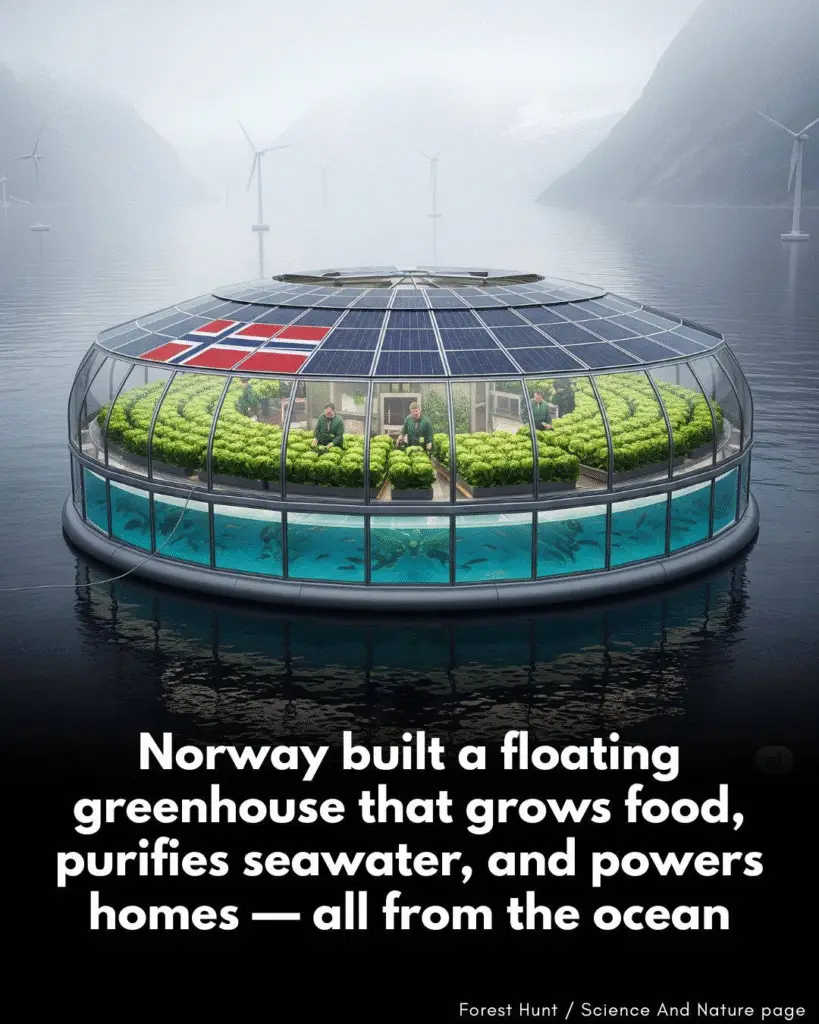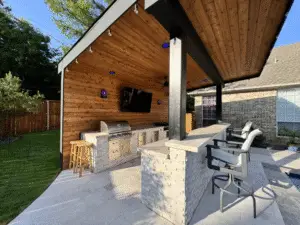Bergen, Norway – July 2025 — In a bold step toward sustainable living and climate resilience, Norwegian engineers have launched a groundbreaking innovation that could redefine how we grow food and harness energy. Floating off the coast near Bergen, the newly unveiled “Ocean Bloom” is a self-sustaining, circular greenhouse island that seamlessly integrates agriculture, aquaculture, desalination, and renewable energy — all in one elegant, floating structure.

A Revolution in Food and Energy Production
Ocean Bloom is more than just a greenhouse — it’s a living ecosystem. Built atop a sturdy pontoon, the floating ring houses a climate-controlled greenhouse filled with rows of leafy greens growing not in soil, but in water. This is made possible through aquaponics — a closed-loop farming method where plants grow in nutrient-rich water sourced from fish tanks. The fish, housed in underwater enclosures beneath the platform, provide natural fertilizer through their waste, which is then filtered and circulated back to nourish the plants.
No synthetic chemicals or fertilizers are used in the process. Instead, Ocean Bloom relies entirely on renewable resources: sunlight, seawater, and air.
Powered by Sun, Wind, and Waves
The entire platform is powered by an integrated system of solar panels, wind turbines, and a state-of-the-art desalination unit. Using solar-heated steam and wave motion, seawater is efficiently converted into freshwater to irrigate the crops. Any surplus freshwater can also be used for nearby communities or stored for future use.
This desalination process is not energy-intensive thanks to the clever use of solar and mechanical wave energy — an approach that has garnered attention from sustainability experts worldwide. Not only does the system provide water and food, but it also generates excess electricity, which can be used to power coastal villages, floating labs, or even off-grid communication buoys.
Remarkable Yields, Minimal Footprint
In early trials, Ocean Bloom has demonstrated agricultural yields over five times higher per square meter than traditional land farming. All without using an inch of soil, generating emissions, or producing agricultural waste. Leafy greens, herbs, and even certain root vegetables thrive under the controlled conditions, free from pests and weather extremes.
The floating greenhouse also contributes positively to the marine environment. A surrounding algae bioreactor ring captures and stores carbon dioxide from the atmosphere and ocean, acting as a carbon sink that helps mitigate ocean acidification. This process not only improves local water quality but contributes to broader climate stability.
Floating Toward the Future
Norway envisions Ocean Bloom as the first of many — a scalable solution designed for a planet facing rising seas and shrinking arable land. The government has announced plans to export the technology to archipelagos and low-lying nations most vulnerable to climate change. Pilot partnerships are already being explored in Southeast Asia, the South Pacific, and parts of Africa.
“This project is about hope,” said Liv Eide, a lead engineer with Oceanix Norway, the startup behind the initiative. “It shows that with the right design, we don’t have to choose between food, energy, and the environment. We can have all three — sustainably.”
Like Us on Facebook!
As the world confronts the twin crises of climate change and food insecurity, floating innovations like Ocean Bloom may soon become essential infrastructure. Far from science fiction, these self-contained ecosystems offer a glimpse into a future where humanity works in harmony with the ocean — turning rising tides into opportunity


















